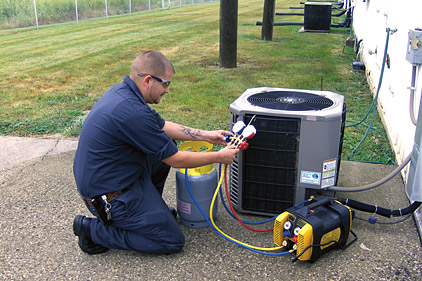
|
| One option available to all competent service technicians to stretch the life of refrigerants is to recover and recycle refrigerant. |
By now, most of us in the HVACR industry are aware of and have been affected by the rising cost of HCFC-22 due to the Environmental Protection Agency (EPA) allocation announcement earlier this year.
For those of us involved with the refrigerant side of the industry, this announcement did not come as a surprise. We were well aware that the R-22 supply was abundant and its phaseout was not meeting EPA expectations. We saw this announcement by the EPA as the inevitable phaseout of HCFCs happening sooner rather than later.
Whether we like it or not, R-22 is going away, and technicians need to look at their best options and solutions to work with the phaseout.
Options
One of my responsibilities in the Technical Support Department at ICOR International is to take phone calls from technicians. I field several a day from technicians and equipment owners from all across the country. Concerning R-22, many of these calls are related to the skyrocketing price of the refrigerant and its limited availability. They want to know what is happening, why it is happening so fast, and what their options are.
One option available to all competent service technicians is to recover and recycle refrigerant.
Recycling refrigerant is the basic process of removing particulate matter, moisture, and acid from a filter drier, or series of driers, and possibly separating some of the oil. This on-site process does not purify refrigerant and should not be confused with reclamation.
Onsite recycling has been an option for many years but not seriously considered until now and now is being considered due to the uncertainty and rising cost of R-22. Many technicians in the field today were not around during the CFC phaseout so they may not be familiar with proper recovery, recycling, and reclaim procedures.
A disturbing trend we are hearing about recently to avoid purchasing expensive R-22 and to save time on the job, is that some technicians are recovering R-22 and recharging equipment with the same R-22 — but without any chemical analysis or using any accepted recycling procedures. I can say that as a veteran service technician with over 30 years of field experience, this practice should not even be considered. It can lead to a number of serious and expensive problems including repetitive service calls (callbacks) and even system failure.
Reclamation
We are encouraging users to return their recovered refrigerant to an EPA-certified refrigerant reclaim service provider (now commonly offered by most wholesale distributors). This will ensure the refrigerant is distilled properly and returned to a virgin standard of purity (ARI-700).
When dealing with refrigerant at the job site, consider ways to reduce the potential for system contamination, such as:
• When possible, check for acid. If present, replace recovered refrigerant with new refrigerant. Cleaning contaminated refrigerant in the field is not practical.
• Ensure the recovery tank is clean and dry. Pull into a good vacuum.
• During the recovery process, run the refrigerant through a filter drier.
• Install new filter driers on equipment and vacuum to 500 microns prior to recharging.
Time is an important factor. But this is one area in which taking a shortcut should not be considered. Doing it right the first time will prevent costly callbacks. Do your part to keep comfort cooling affordable.
Publication date: 7/2/2012









